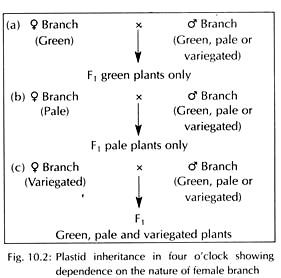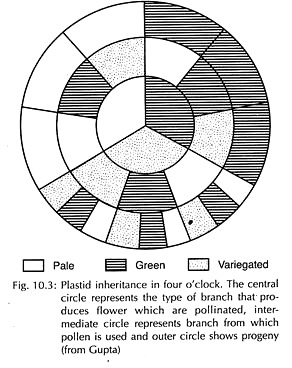The following points highlight the top two types of Cytoplasmic Organellar Inheritance. The types are: 1. Plastid Inheritance 2. Mitochondrial Inheritance.
Cytoplasmic Organellar Inheritance: Type # 1. Plastid Inheritance:
The most established cases of true cytoplasmic inheritance are those that involve plastids, which are minute cytoplasmic organelles in plant cells. Most important of these plastids are chloroplastids carrying green pigment, the chlorophyll.
Chloroplastids duplicate themselves independent of other parts of the cell and carry some genetic information in the form of DNA (cp DNA). Obviously, these chloroplastids are transmitted through the cytoplasm of the egg and only a small amount rarely transmitted through pollen.
Consequently, characters depending on plastids exhibit cytoplasmic inheritance, sometimes independent of nuclear genes. The inheritance pattern of the genes located in plastids is best exemplified in the classical experiments utilizing several plants like Primula sinensis, Mirabilis jalapa, Zea mays and species of Oenothera.
Variegation in Four O’clock Plant:
In Mirabilis jalapa (four o’clock plant), the leaves on certain branches of a plant may be fully green; other branches have patchy leaves in which green tissue is interspersed with pale- green to white tissue in a variegated pattern; and other branches bear fully pale leaves.
Microscopic examination of the green leaves and the green areas of the variegated leaves reveals that the cells contain normal chloroplastids and chlorophyll pigment, whereas the pale- leaves and pale patches lack normal chloroplastids and pigment. When the inheritance of these pigment traits is examined, it is found that the phenotype of the progeny will depend upon phenotype of the female parent (Figs. 10.2, 10.3).
Ovules derived from fully green portions of the plant, regardless of the source of pollen, will result only fully green plants and variegated character will not reappear in the subsequent generations.
When ovules are derived from variegated branches, three types of seeds are produced in variable numbers, again regardless of the male parent; some give rise to (sure green, some to pure white, and the majority to variegated offspring’s. Ovules derived from pale branches, will result only pale plants.
Plastid System in Oenothera:
Crosses between species of Oenothera, reveal interesting results in Renner’s experiment. Reciprocal hybrids obtained by crossing the two species, O. muricata and O. hookeri (both are green), were different (Fig. 10.4A).
The nuclei in the reciprocal hybrids are the same, but the difference involves only in cytoplasm. The yellow F1 seedling dies but green seedling from ‘muricata’ mother remains normally green but occasionally develops flex of yellow in the shoots. These are evidently ‘hookeri’ plastids which have come with the pollen and sorted themselves out during development to make the full plastid complement of certain cells.
Such regions develop branches, and flowering occurs on them. On selfing of such flower the following combinations are expectated – homozygous ‘muricata’, homozygous ‘hookeri’ and heterozygous ‘muricata’ and ‘hookeri’, all containing ‘hookeri’ cytoplasm. Homozygous ‘muricata’dies in embryo, homozygous ‘hookeri’ is green like the original ‘hookeri’ and hetero- zygote is again yellow.
This shows again that as soon as the ‘hookeri’ nuclei are placed in its own cytoplasm, they turned green. These results suggest that the plastid systems of the two species are adapted to their own nuclei. This is a clear evidence of the plastids of the cytoplasm playing a role in heredity.
Lojap Character in Corn:
Lojap character (green and white stripes in leaf) in corn is controlled by nuclear recessive gene (ij), dominant allele (Ij) is responsible for normal green colour.
But iojap character once inherited through female parent will be able to maintain itself in cytoplasm irrespective of genotype of plant. Female gametes from ijij can carry either only green or white or both plastids. Therefore, crossing between female ijij with male Ijlj plant will produce F1 plants (ijij) which may be green, white or striped (Fig. 10.4B).
Striped Fi (Ijij) female plants when crossed with green Ijlj male, both the genotypes (Ijlj and Ijij) obtained show three types of phenotypes (green, white, striped). Therefore, iojap or striped phenotype may have three genotypes – Ijlj, Ijij, ijij.
Plastidial Genome (cp DNA):
Chloroplasts may have circular or linear DNA molecule of genomic size ranging from 120 to 400 kb controlling the synthesis of specific RNA and protein molecules. Several genes were reported to be located on chloroplast genome and genetic maps have been prepared in Chlamydomonas, maize etc.
Cytoplasmic Organellar Inheritance: Type # 2. Mitochondrial Inheritance:
The inheritance pattern in some cases are controlled by the genes present in mitochondria, are transmitted through cytoplasm of the eggs.
Male Sterility in Plants:
This is an example of cytoplasmic inheritance associated with pollen failure in many flowering plants. In maize, wheat, sugar beets, onions, mustards and millets, fertility is controlled at least in part by cytoplasmic factors. In such cases, if female parent is male sterile, F, progeny would always be male sterile (Fig. 10.5A, B). Here the cytoplasm is mainly derived from egg produced by male sterile female parent.
Rhoades (1933) reported the analysis of first cytoplasmic male sterile plants in maize and demonstrated that male sterility was contributed by female parent and nuclear genes had no influence. A particular male sterile plant produced only male sterile plant progeny when fertilized with pollen from normal maize plants.
The male sterile seed-parent plants were then back crossed repeatedly with pollen-fertile lines until ail chromosomes from the male sterile line had been exchanged for those of the male fertile line.
In the genetically restored sterile line, male sterility persisted, demonstrating that inheritance was maternal and not controlled by chromosomal genes. As the investigations progressed, a small amount of pollen was obtained from the male sterile line, making reciprocal crosses possible.
These crosses produced progeny from the male sterile seed plant line that were male fertile. Thus inheritance of male sterility was maternal, regardless of the direction in which the cross was made. Recent studies have proved that factors responsible for cytoplasmic male sterility are principally located in mitochondrial DNA (mtDNA).
Poky Mutant in Neurospora:
A poky mutant in Neurospora differs from wild type in the following attributes:
(a) It is slow-growing;
(b) It shows maternal inheritance; and
(c) It has abnormal cytochromes (cytochromes are proteins needed for oxidation and generation of ATP energy). Of the three cytochromes, cyt a, b and c found in the wild type, cyt a and b are absent and cyt c is in excess in poky mutant.
In reciprocal crosses, poky character shows maternal inheritance.
Following evidences suggest that poky may be located in mitochondrial genome:
(i) Slow growth may be due to lack of ATP energy and source of this energy is mitochondria;
(ii) Cytochromes in poky differ from those in wild type in quality and quantity and these cytochromes are found in mitochondria.
Petite Mutants in Yeast:
Petite in yeast differs from wild grande in having defective aerobic respiratory mechanism.
The genetic basis of petite character is a cytoplasmic factor ρ+(rho) present in mitochondria exhibiting nonsegregational nature (vegetative petites). In vegetative petites, this factor may be absent (p0) as in neutral petites which are not transmitted or defective (ρ–) as in suppressive petites which are transmitted to a fraction of vegetative diploid progeny.
Mitochondrial Genome (mt DNA):
Mitochondria also contain circular DNA, may be linear in some cases. The mitochondrial genomic size may vary from 15 to 2400 kb controlling the synthesis of specific RNA and protein molecule. Mapping of mitochondrial genome has been done in yeast, human and others.






